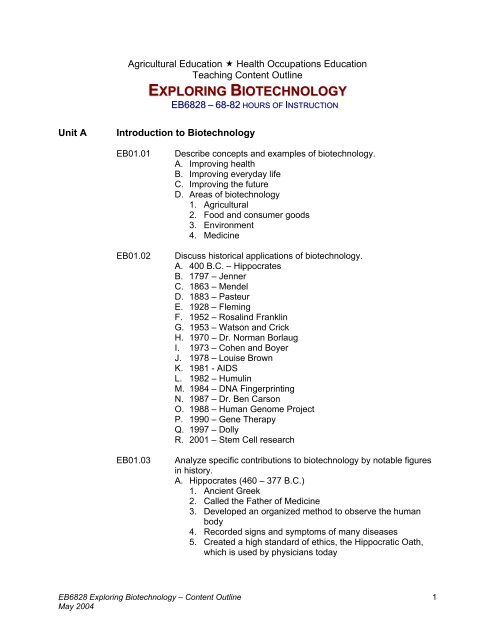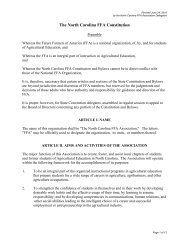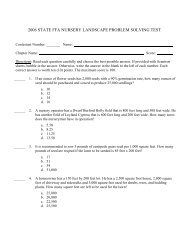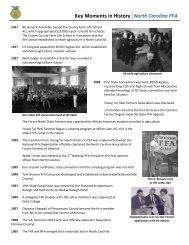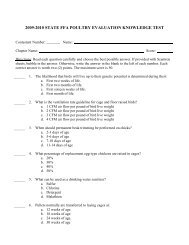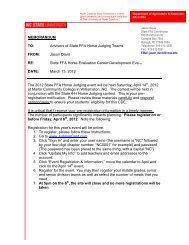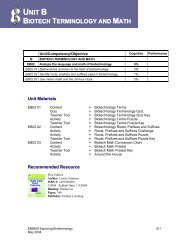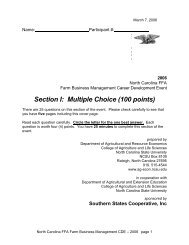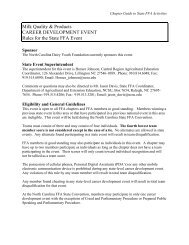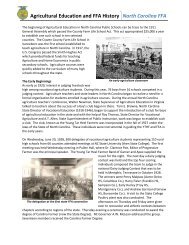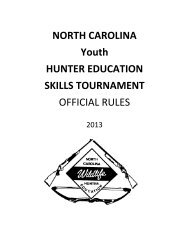EXPLORING BIOTECHNOLOGY - NC FFA
EXPLORING BIOTECHNOLOGY - NC FFA
EXPLORING BIOTECHNOLOGY - NC FFA
- No tags were found...
You also want an ePaper? Increase the reach of your titles
YUMPU automatically turns print PDFs into web optimized ePapers that Google loves.
Agricultural Education Health Occupations EducationTeaching Content Outline<strong>EXPLORING</strong> <strong>BIOTECHNOLOGY</strong>EB6828 – 68-82 HOURS OF INSTRUCTIONUnit AIntroduction to BiotechnologyEB01.01EB01.02EB01.03Describe concepts and examples of biotechnology.A. Improving healthB. Improving everyday lifeC. Improving the futureD. Areas of biotechnology1. Agricultural2. Food and consumer goods3. Environment4. MedicineDiscuss historical applications of biotechnology.A. 400 B.C. – HippocratesB. 1797 – JennerC. 1863 – MendelD. 1883 – PasteurE. 1928 – FlemingF. 1952 – Rosalind FranklinG. 1953 – Watson and CrickH. 1970 – Dr. Norman BorlaugI. 1973 – Cohen and BoyerJ. 1978 – Louise BrownK. 1981 - AIDSL. 1982 – HumulinM. 1984 – DNA FingerprintingN. 1987 – Dr. Ben CarsonO. 1988 – Human Genome ProjectP. 1990 – Gene TherapyQ. 1997 – DollyR. 2001 – Stem Cell researchAnalyze specific contributions to biotechnology by notable figuresin history.A. Hippocrates (460 – 377 B.C.)1. Ancient Greek2. Called the Father of Medicine3. Developed an organized method to observe the humanbody4. Recorded signs and symptoms of many diseases5. Created a high standard of ethics, the Hippocratic Oath,which is used by physicians todayEB6828 Exploring Biotechnology – Content OutlineMay 20041
B. Louis Pasteur (1822 – 1895)1. Proved that microorganisms cause disease2. Pasteurized milk to kill bacteria3. Created a vaccine for rabiesC. Gregor Mendel (1822-1884)1. Did research on hybridity in plants2. Established that dominant and recessive traits(genes) exist in living things3. Father of GeneticsD. Rosalind Franklin (1920-1958)1. Chemist at King’s College in London2. Produced early data critical to the discovery of DNA3. Was not given credit for her work because she was awomanE. James Watson and Francis Crick1. In 19532. Described the structure of DNA3. Described how DNA carries genetic informationF. Stanley Cohen and Herbert Boyer1. In 19732. They invented a method of cloning genetically engineeredmolecules in foreign cells3. This initiated what is now the multibillion-dollarbiotechnology industryG. Dr. Ben Carson1. World renowned African-American surgeon2. Director of Pediatric Neurosurgery at Johns Hopkins3. In 1987, first surgeon to successfully separate Siamesetwins joined at the headH. Dr. Norman E. Borlaug1. From Iowa2. 1970 Nobel Prize-winning agricultural researcher3. Known for research with wheat and feeding the worldpopulationI. Dr. Ian Wilmut1. Scotland, 19972. Headed the team that cloned Dolly using DNA from adultsheep cells3. Known for ground-breaking biological research and experton cloningEB6828 Exploring Biotechnology – Content OutlineMay 20042
Unit BBiotech Terminology and MathEB02 Analyze the language and math of biotechnology.EB02.01EB02.02Define terms common to the field of biotechnology.A. Amino acidB. BioinformaticsC. BioprocessingD. BioreactorE. CellF. ChromosomeG. CloneH. CultureI. DNA (deoxyribonucleic acid)J. EnzymeK. FermentationL. GeneM. Genetic engineeringN. GenomeO. HybridP. MutationQ. Nucleic acidR. PhenotypeS. PlasmidT. ProteinIdentify roots, prefixes and suffixes used in biotechnology.A. Roots1. bio2. carcin3. chem.4. cryo5. cyte6. forens7. genic, genetic8. pharm9. med10. mutat11. tech12. thermB. Prefixes1. a-, an-2. anti-3. aqua-4. auto-5. bi-6. eu-7. extra-8. intra-9. micro-10. mono-EB6828 Exploring Biotechnology – Content OutlineMay 20043
11. patho-12. poly-13. toxi-14. trans-C. Suffixes1. -able2. -ase3. -al4. -cide5. -degrade6. -ic7. -ologist8. -ology9. -scopeEB02.03Use metric math and the 24 hour clock.A. Convert pounds to kilograms and kilograms to pounds.B. Convert metric length, weight and volumeC. Identify metric terms and abbreviationsD. 24 hour clockUnit CLaboratory Safety and Infection ControlEB03 Analyze methods for protecting the safety of biotech workers and the public.EB03.01Analyze the use of equipment and materials and apply rules forsafety in the laboratory.A. Laboratory equipment1. Beaker2. Concave microscope slide3. Disposable pipette4. Flask5. Forceps6. Funnel7. Gloves8. Graduated cylinder9. Hot water bath10. Hot plate11. Incubator12. Medicine dropper13. Monocular microscope14. Petri dish15. Pipette16. Pipette pump17. Safety glasses18. Scalpel19. Stirring rod20. Test tubes21. Test tube rack22. ThermometerEB6828 Exploring Biotechnology – Content OutlineMay 20044
B. Laboratory safety1. General laboratory guidelines2. Personal safety3. Equipment safetyEB03.02EB03.03Use correct body mechanics.A. Healthy body mechanicsB. Rules for body mechanicsC. Posture1. Chin tuck2. Shoulder squeezesAnalyze methods of infection control.A. Microoganisms1. Bacteria2. Protozoa3. Fungi4. Rickettsiae5. Viruses6. EnvironmentB. Pathogens1. Cause of infection2. Nosocomial infections3. Opportunistic infections4. Transmission of diseaseC. Infection control1. Asepsis2. Aseptic techniqueD. HandwashingE. Alcohol-based handrubUnit DCellular Design and DNAEB04 Investigate cellular design and DNA.EB04.01EB04.02Discuss the nature of science, scientific inquiry and problemsolving.A. What is science?B. How to think like a scientistC. How to act like a scientist1. Observation2. Hypothesis3. Experiment4. ConclusionAnalyze cellular design and function in plant, animal and bacterialcells.A. Cell theoryB. Structure and scale of molecules in the cellC. Using a microscopeEB6828 Exploring Biotechnology – Content OutlineMay 20045
D. Animal cell1. Nucleus2. Cytoplasm3. Mitochondria4. Cell membrane5. Lysosomes6. Ribosomes7. Golgi apparatus8. Centrioles9. Nucleolus10. Endoplasmic reticulumE. Plant cell1. Nucleus2. Cell wall3. Cell membrane4. Chloroplasts5. Cytoplasm6. Vacuoles7. Mitochondria8. Ribosomes9. Endoplasmic reticulumF. Bacterial Cell1. Cocci2. Bacilli3. Spirochetes4. Partsa. Cell wallb. Cytoplasmc. Cell membraned. Flagellae. Nucleoidf. RibosomesEB04.03Explore the structure of DNA and its relationship to the cell.A. Genetics and DNA1. Gene2. Domineering genes3. Mutations4. Secret codes5. Genes across the agesB. Genome science1. DNA2. Base pairsa. adenine (A)b. thymine (T)c. guanine (G)d. cytosine (C)3. Chromosomes4. ProteinsEB6828 Exploring Biotechnology – Content OutlineMay 20046
EB04.04Evaluate forensic techniques.A. Forensic scienceB. Forensic scientistsC. TechniquesD. DNA typingE. Firearms and toolmarksF. Forensic profilingG. Document examinationH. AutopsyI. Forensic anthropologyJ. OdontologyK. BloodUnit EAgricultural BiotechnologyEB05 Analyze the science of plants, food and animals in agricultural biotechnology.EB05.01Discuss the fundamentals of biotechnology in agriculture.A. Crop biotechnologyB. Improving crop production1. Natural protection for plants2. Herbicide tolerance3. Increasing yieldsC. Environmental and economic benefitsD. Forest biotechnologyE. Animal biotechnology1. Increasing livestock productivity2. Animal biotech to enhance human medical applicationsF. AquacultureG. Terminology1. Cloning2. Tissue culture3. Cuttings4. Grafting5. Hormones6. Genetic engineering7. Benefits of biotechnologyH. Classical biotechnology1. Mendel’s pea plants2. Crossbreeding3. TraitsEB6828 Exploring Biotechnology – Content OutlineMay 20047
EB05.02EB05.03EB05.04EB05.05Analyze biotechnology and plants.A. Fast plantsB. Asexual reproduction in plants1. Rhizomes2. Tubers3. Runners4. Cuttings5. Bulbs6. Corms7. Cell culture8. Tissue cultureC. Inherited traitsD. VariationE. Plant-made pharmaceuticalsInvestigate when various techniques of food biotechnology wereintroduced.A. B.C. time periodB. 1 AD to 900 ADC. 900-1970D. 1970-1996E. FutureAnalyze the production and processing of genetically modifiedfoods.A. Plant biotechnologyB. Commercial biotechnology productsC. Enhancement of biotech cropsD. Benefits of biotech cropsE. Regulatory agenciesF. Countries that use biotech cropsDiscuss the use of transgenic farm animals.A. Selective breedingB. Mouse – first transgenic animalC. Benefits of transgenic animalsD. Future benefitsE. Herman – the transgenic bullF. Better cheeseG. Production of transgenic animals1. Use of recombinant DNA technology2. Transgenes3. DNA microinjection4. Measure for successEB6828 Exploring Biotechnology – Content OutlineMay 20048
Unit FBiotechnology in Health CareEB06 Analyze biotechnology in health care.EB06.01EB06.02Describe computer applications and biomedical devices in healthcare.A. Value and extent of computer useB. Examples1. Information systems2. Confidentiality3. Medical laboratory4. Electrocardiogram5. Echocardiogram6. Computerized tomography7. Magnetic resonance imaging8. Ultrasonography9. Telemedicine10. Bioinformatics11. Human genome projectC. Biomedical devices.1. Home diagnostic kits2. Blood glucose monitoring3. Fetal monitors and ultrasound4. Ventilator5. Defibrillator6. Assistive devices7. Operating roomDiscuss the human genome project and genetic engineering.A. Human Genome Project1. International effort2. Gene mappingB. What is a genome?1. Adenine-thymine2. Bioinformatics3. Cell4. Chromosome5. DNA6. Forensics7. Gene8. Genetic map9. Genomics10. Nucleus11. Human genome projectC. Genetic engineering1. Recombinant DNA2. Genetic engineering in health care3. Gene therapyD. Genetic traitsE. Cloning and stem cell researchEB6828 Exploring Biotechnology – Content OutlineMay 20049
EB06.03EB06.04Analyze genes and disease.A. Diagnosing and predictingB. Disease interventionC. Gene mutationD. Dominant and recessive genesDescribe the use of recombinantly produced drugs andpharmacogenomics.A. Description of biotech drugsB. Examples of medical useC. Production stepsD. PharmacogenomicsUnit GIndustrial and Environmental BiotechnologyEB07 Analyze the use of biotechnology applications in industry and the environment.EB07.01EB07.02EB07.03Discuss industrial and environmental biotechnology.A. Biobased energyB. Biobased productsC. BiocatalytsD. BiomaterialsE. BioprocessingF. BioremediationG. BioreportersH. BiosensorsI. CompostingJ. MicrobesAnalyze components of industrial biotechnology.A. Fermentation1. Yeast2. Ethanol3. Stillage4. Bioprocessing factoryB. BiominingC. CompostingEvaluate environmental biotechnology applications.A. BioremediationB. EnzymesC. Biotechnology patentsD. BiosensorsEB6828 Exploring Biotechnology – Content OutlineMay 200410
Unit HBiomedical ResearchEB08 Analyze biomedical research methods.EB08.01EB08.02EB08.03Identify components of biomedical research.A. Basic researchB. Applied researchC. Clinical researchDiscuss biomedical research methods.A. Applied research1. Chemical, mechanical, mathematical and computersimulations2. In vitro tests3. Non-human animal models4. Human studies5. Epidemiological studiesB. Clinical research1. Phase I2. Phase II3. Phase III4. Strengths and limitationsAnalyze the benefits of biomedical research.A. Activities influenced by biomedical researchB. Biomedical research advancesC. Polio (Infantile Paralysis)D. Advances that benefit animalsE. Research for animal healthUnit IBioethicsEB09 Analyze ethical and professional standards in health care and biotechnology.EB09.01Discuss basic rules of ethics and patient rights.A. List at least six basic rules of ethics for health care personnel.1. Put the saving of life and promotion of health above all else2. Keep the patient as comfortable as possible, preserve life3. Respect the patient’s choice to die with dignity4. Treat all patients equally, regardless of race, religion,social or economic status, sex or nationality5. Provide care for ALL individuals to the best of your ability6. Maintain a competent level of skill consistent with yourparticular occupation7. Maintain patient confidentiality8. Refrain from immoral, illegal and unethical practices, andreport any you see9. Show loyalty to patients, coworkers and employers10. Be sincere, honest and caring – respecting the rights anddignity of othersEB6828 Exploring Biotechnology – Content OutlineMay 200411
B. List as least six rights of the patient who is receiving healthcare.1. Right to considerate and respectful care2. Right to obtain complete, current information concerningdiagnosis, treatment, and prognosis3. Right to receive information necessary to give informedconsent prior to the start of any procedure or treatment4. Right to have advance directives for health care and/orrefuse treatment to the extent permitted under law5. Right to confidential treatment of all communications andrecords6. Right to a reasonable response to a request for services7. Right to review medical records and examine bills andreceive an explanation of all care and chargesEB09.02Analyze professional standards in health care and biotechnology.A. Justify at least eight professional healthcare standards byexplaining how they help meet ethical requirements.1. Perform only those procedures for which you have beentrained and are legally permitted to do.2. Use approved, correct methods while performing anyprocedure.3. Obtain proper authorization before performing anyprocedure.4. Identify the patient and obtain the patient’s consent beforeperforming any procedure.5. Observe all safety precautions.6. Keep all information confidential.7. Think before you speak and carefully consider everythingyou say.8. Treat all patients equally regardless of race, religion, socialor economic status, sex or nationality.9. Accept no tips or bribes for the care you provide.10. If any error occurs or you make a mistake, report itimmediately to your supervisor.11. Behave professionally in dress, language, manners andactions.EB09.03Research and debate selected bioethical issues.A. Organ transplantsB. CloningC. Genetic testingD. Gene therapyE. Physician assisted suicideF. Bioengineered foodsG. Stem cell researchH. Transgenic organismsI. Genetic engineeringEB6828 Exploring Biotechnology – Content OutlineMay 200412
Unit JCareers in BiotechnologyEB10 Analyze careers in biotechnology, bioinformatics, biomanufacturing, agricultureand health care.EB10.01EB10.02EB10.03EB10.04Describe careers in biotechnology.A. Veterinary technologists/techniciansB. Technical writersC. Biological techniciansD. Biochemists/biophysicistsE. Agricultural and food science techniciansF. Sales representativeG. Greenhouse technicianH. Instrumentation/Calibration TechnicianI. Laboratory assistantJ. Clinical research associateK. ToxicologistL. Other biotechnology careersAnalyze bioinformatics and biomanufacturing careers.A. Bioinformatics programmerB. Manufacturing technicianC. Quality control technicianD. Documentation coordinatorE. Bioprocessing technicianF. Other bioinformatics and biomanufacturing careersAnalyze careers in agriculture that support biotechnology.A. Agricultural inspectorsB. Farm labor contractorsC. Animal breedersD. Agriculture Equipment operatorsE. First line supervisors and managers – Animal husbandryF. Farmworkers and Laborers, crop, nursery and greenhouseG. Graders and sorters, agricultural productsH. Other agriculture careersAnalyze careers in health care that support biotechnology.A. Dental HygienistB. Medical (Clinical) Laboratory TechnologistC. Radiologic TechnologistD. Biomedical Equipment TechnicianE. EMTF. Medical Records AdministratorG. Health Care AdministratorH. PhysicianI. Physician’s AssistantJ. Registered NurseK. DieticianL. PharmacistEB6828 Exploring Biotechnology – Content OutlineMay 200413
M. Physical TherapistN. VeterinarianO. Other health care careersEB10.05EB10.06Create a personal career development plan.A. Investigate at least one health career by using the Internet togather additional information on the career.B. Create a Career Development Plan.Demonstrate professional qualities and leadership skills.A. Demonstrate the standards of a professional appearance asthey apply to uniforms, clothing, shoes, nails, hair, jewelry, andmakeup.1. Uniformsa. Many biotechnology and healthcare professionsrequire a uniformb. Should be neat, well fitting, clean and no wrinklesc. In some agencies, colors identify groups of workers2. Clothinga. If regular clothing worn, it should be clean, neat andwell fittingb. Should be appropriate for the jobc. Washable is bestd. Wear a name badge or ID as required by facility3. Shoesa. Some careers require special shoesb. Low heels usually bestc. In most careers, avoid tennis shoes or sandals4. Nailsa. Part of good personal hygieneb. Short and cleanc. Avoid nail polish, or wear clear/colorlessd. Use lotion to prevent frequently washed hands frombecoming chapped or dry5. Haira. Keep in clean and neatb. Avoid extreme hairstyles and hair ornamentsc. If job requires close patient contact or safety concerns,long hair should be pinned back or a hair net worm asrequired by the specific industry6. Jewelrya. Usually not permitted, except watch, wedding ring, andsmall pierced earringsb. Body jewelry (nose, eyebrow, tongue piercing) isusually not permitted in a healthcare facility and somebiotechnology industries7. Makeupa. Used to create a natural, attractive appearanceb. Avoid excessive makeupEB6828 Exploring Biotechnology – Content OutlineMay 200414
B. Identify why teamwork is beneficial in work1. Teamwork improves communication and continuity of care2. Every person on the team must understand the role of theother team members.C. Identify six basic characteristics of leaders.1. Respect the rights, dignity, opinions, and abilities of others.2. Understand the principles of democracy.3. Work with a group to guide the group toward a goal.4. Understand own strengths and weaknesses.5. Display self-confidence and willingness to take a stand.6. Communicate effectively and verbalize ideas clearly.7. Shows initiative, a willingness to work, and completestasks.8. Shows optimism, is open-minded, and can compromise.9. Praises others and gives credit to others.10. Dedicated to meeting high standards.D. Apply leadership etiquette to include: shaking hands, standing,sitting, introductions, and writing thank you notes.1. How to stand2. How to sit3. How to stand after sitting4. Shaking hands5. Introductions6. Introducing a speaker7. Writing thank you notesEB6828 Exploring Biotechnology – Content OutlineMay 200415


